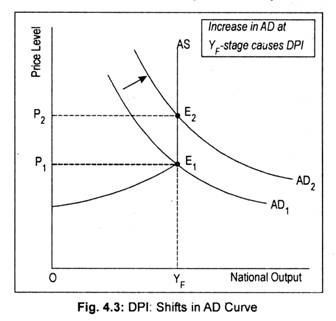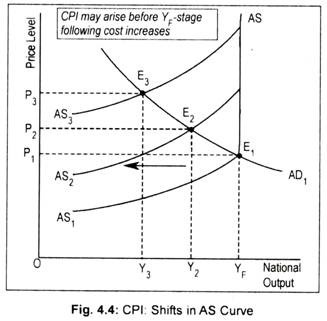Causes of Inflation: Inflation is mainly caused by excess demand/ or decline in aggregate supply or output. Former leads to a rightward shift of the aggregate demand curve while the latter causes aggregate supply curve to shift leftward. Former is called demand-pull inflation (DPI), and the latter is called cost-push inflation (CPI). Before describing the factors, that lead to a rise in aggregate demand and a decline in aggregate supply, we like to explain “demand-pull” and “cost-push” theories of inflation.
(i) Demand-Pull Inflation Theory: There are two theoretical approaches to the DPI—one is classical and other is the Keynesian. According to classical economists or monetarists, inflation is caused by an increase in money supply which leads to a rightward shift in negative sloping aggregate demand curve. Given a situation of full employment, classicists maintained that a change in money supply brings about an equiproportionate change in price level.
That is why monetarists argue that inflation is always and everywhere a monetary phenomenon. Keynesians do not find any link between money supply and price level causing an upward shift in aggregate demand. According to Keynesians, aggregate demand may rise due to a rise in consumer demand or investment demand or government expenditure or net exports or the combination of these four components of aggregate demand. Given full employment, such increase in aggregate demand leads to an upward pressure in prices. Such a situation is called DPI. This can be explained graphically.

Just like the price of a commodity, the level of prices is determined by the interaction of aggregate demand and aggregate supply. In Fig. 4.3, aggregate demand curve is negative sloping while aggregate supply curve before the full employment stage is positive sloping and becomes vertical after the full employment stage is reached. AD1 is the initial aggregate demand curve that intersects the aggregate supply curve AS at point E1.
The price level, thus, determined is OP1. As aggregate demand curve shifts to AD2, price level rises to OP2. Thus, an increase in aggregate demand at the full employment stage leads to an increase in price level only, rather than the level of output. However, how much price level will rise following an increase in aggregate demand depends on the slope of the AS curve.
(ii) Causes of Demand-Pull Inflation: DPI originates in the monetary sector. Monetarists’ argument that “only money matters” is based on the assumption that at or near full employment excessive money supply will increase aggregate demand and will, thus, cause inflation.
An increase in nominal money supply shifts aggregate demand curve rightward. This enables people to hold excess cash balances. Spending of excess cash balances by them causes price level to rise. Price level will continue to rise until aggregate demand equals aggregate supply.
Keynesians argue that inflation originates in the non-monetary sector or the real sector. Aggregate demand may rise if there is an increase in consumption expenditure following a tax cut. There may be an autonomous increase in business investment or government expenditure. Government expenditure is inflationary if the needed money is procured by the government by printing additional money.
In brief, increase in aggregate demand i.e., increase in (C + I + G + X – M) causes price level to rise. However, aggregate demand may rise following an increase in money supply generated by the printing of additional money (classical argument) which drives prices upward. Thus, money plays a vital role. That is why Milton Friedman argues that inflation is always and everywhere a monetary phenomenon.
There are other reasons that may push aggregate demand and, hence, price level upwards. For instance, growth of population stimulates aggregate demand. Higher export earnings increase the purchasing power of the exporting countries. Additional purchasing power means additional aggregate demand. Purchasing power and, hence, aggregate demand may also go up if government repays public debt.
Again, there is a tendency on the part of the holders of black money to spend more on conspicuous consumption goods. Such tendency fuels inflationary fire. Thus, DPI is caused by a variety of factors.
(iii) Cost-Push Inflation Theory: In addition to aggregate demand, aggregate supply also generates inflationary process. As inflation is caused by a leftward shift of the aggregate supply, we call it CPI. CPI is usually associated with non-monetary factors. CPI arises due to the increase in cost of production. Cost of production may rise due to a rise in cost of raw materials or increase in wages.
However, wage increase may lead to an increase in productivity of workers. If this happens, then the AS curve will shift to the right- ward not leftward—direction. We assume here that productivity does not change in spite of an increase in wages.
Such increases in costs are passed on to consumers by firms by raising the prices of the products. Rising wages lead to rising costs. Rising costs lead to rising prices. And, rising prices again prompt trade unions to demand higher wages. Thus, an inflationary wage-price spiral starts. This causes aggregate supply curve to shift leftward.

This can be demonstrated graphically where AS1 is the initial aggregate supply curve. Below the full employment stage this AS curve is positive sloping and at full employment stage it becomes perfectly inelastic.
Intersection point (E1) of AD1 and AS1 curves determine the price level (OP1). Now there is a leftward shift of aggregate supply curve to AS2. With no change in aggregate demand, this causes price level to rise to OP2 and output to fall to OY2. With the reduction in output, employment in the economy declines or unemployment rises. Further shift in AS curve to AS3 results in a higher price level (OP3) and a lower volume of aggregate output (OY3). Thus, CPI may arise even below the full employment (YF) stage.
(iv) Causes of Cost-Push Inflation: It is the cost factors that pull the prices upward. One of the important causes of price rise is the rise in price of raw materials. For instance, by an administrative order the government may hike the price of petrol or diesel or freight rate. Firms buy these inputs now at a higher price. This leads to an upward pressure on cost of production.
Not only this, CPI is often imported from outside the economy. Increase in the price of petrol by OPEC compels the government to increase the price of petrol and diesel. These two important raw materials are needed by every sector, especially the transport sector. As a result, transport costs go up resulting in higher general price level.
Again, CPI may be induced by wage-push inflation or profit-push inflation. Trade unions demand higher money wages as a compensation against inflationary price rise. If increase in money wages exceed labour productivity, aggregate supply will shift upward and leftward. Firms often exercise power by pushing prices up independently of consumer demand to expand their profit margins.
Fiscal policy changes, such as increase in tax rates also leads to an upward pressure in cost of production. For instance, an overall increase in excise tax of mass consumption goods is definitely inflationary. That is why government is then accused of causing inflation.
Finally, production setbacks may result in decreases in output. Natural disaster, gradual exhaustion of natural resources, work stoppages, electric power cuts, etc., may cause aggregate output to decline. In the midst of this output reduction, artificial scarcity of any goods created by traders and hoarders just simply ignite the situation.
Inefficiency, corruption, mismanagement of the economy may also be the other reasons. Thus, inflation is caused by the interplay of various factors. A particular factor cannot be held responsible for any inflationary price rise.
4. Effects of Inflation: People’s desires are inconsistent. When they act as buyers they want prices of goods and services to remain stable but as sellers they expect the prices of goods and services should go up. Such a happy outcome may arise for some individuals; “but, when this happens, others will be getting the worst of both worlds.”
When price level goes up, there is both a gainer and a loser. To evaluate the consequence of inflation, one must identify the nature of inflation which may be anticipated and unanticipated. If inflation is anticipated, people can adjust with the new situation and costs of inflation to the society will be smaller.
In reality, people cannot predict accurately future events or people often make mistakes in predicting the course of inflation. In other words, inflation may be unanticipated when people fail to adjust completely. This creates various problems.



